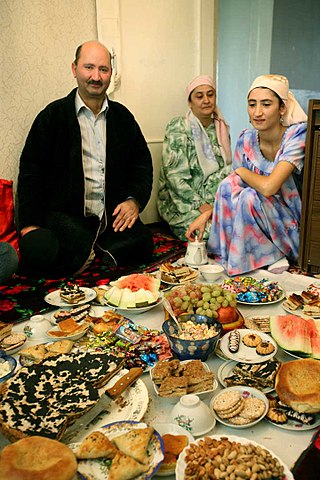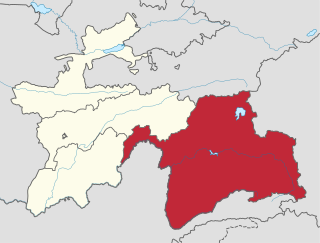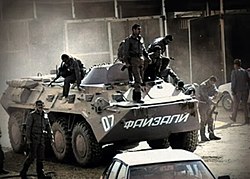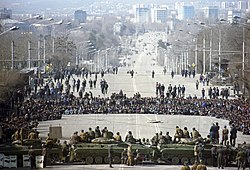
Tajikistan, officially the Republic of Tajikistan, is a landlocked country in Central Asia. Dushanbe is the capital and most populous city. Tajikistan is bordered by Afghanistan to the south, Uzbekistan to the west, Kyrgyzstan to the north, and China to the east. It is separated from Pakistan by Afghanistan's Wakhan Corridor.
The politics of Tajikistan takes place in a framework of a presidential republic, whereby the President is both head of state and head of government, and of a multi-party system. Legislative power is vested in both the executive branch and the two chambers of parliament.

Emomali Rahmon (; born Emomali Sharipovich Rahmonov, Tajik: Эмомалӣ Шарипович Раҳмонов, romanized: Emomalí Šarip Rahmon; ; October 5, 1952, is a Tajik politician who has been serving as 3rd President of Tajikistan since 16 November 1994. Previously he was the Chairman of the Supreme Assembly of Tajikistan, as the de facto head of state from 20 November 1992 to 16 November 1994. Since 18 March 1998, he has also served as the leader of the People's Democratic Party of Tajikistan, which dominates the Parliament of Tajikistan. On 30 September 1999, he was elected vice-president of the UN General Assembly for a one-year term.

The culture of Tajikistan has developed over several thousand years. Tajik culture can be divided into two areas, Metropolitan and Kuhiston (Highland). Modern city centres include Dushanbe, Khudjand, Kulob, and Panjikent.

Gorno-Badakhshan, officially the Badakhshan Mountainous Autonomous Region, is an autonomous region in eastern Tajikistan, in the Pamir Mountains. It makes up nearly forty-five percent of the country's land area but only two percent of its population.

The Pamiris are an Eastern Iranian ethnic group, native to Central Asia, living primarily in Tajikistan (Gorno-Badakhshan), Afghanistan (Badakhshan), Pakistan (Gilgit-Baltistan) and China. They speak a variety of different languages, amongst which languages of the Eastern Iranian Pamir language group stand out. The languages of the Shughni-Rushani group, alongside Wakhi, are the most widely spoken Pamiri languages.

Haji Akbar Turajanzade is a Senator in the National Assembly of Tajikistan. He served as the Qazi Qalon, the highest Muslim authority in Tajikistan, from 1988 to 1991. He served as the second-in-command of the Islamic Renaissance Party of Tajikistan and the United Tajik Opposition from 1993 until his expulsion from the party in 1999. He served as the Deputy Prime Minister in the Tajik government after the civil war.
Davlat Khudonazarov is a Tajik filmmaker, politician and human rights activist.

Lal'i Badakhshan is an opposition political party in Tajikistan. The party was formed by Pamiri people for the purpose of protecting the rights of Pamiris and promoting the autonomy of the Gorno-Badakhshan Autonomous Province.

Islam is the predominant religion in Tajikistan.
The Kulobi people, also spelt Kulyabi or Kulabi, are the inhabitants of the southwest area of Tajikistan.

Relations between Afghanistan and Tajikistan began in 1992. Afghanistan maintains an embassy in Dushanbe and a consulate in Khorugh. The current Afghanistan ambassador to Tajikistan is LTG. Mohammad Zahir Aghbar. Tajikistan maintains an embassy in Kabul and a consulate in Mazari Sharif, Faizabad and Kunduz. The current Tajikistan ambassador to Afghanistan is Sharofiddin Imom.

The Gorno-Badakhshan clashes consisted of fighting between Tajik government forces and an armed group led by Tolib Ayyombekov in Tajikistan's semi-autonomous Gorno-Badakhshan province in late July 2012. The Western media described the fighting as the worst in Tajikistan since 2010 or the 1992–1997 civil war.

Tolibbek Ayyombekov, commonly known as Tolib Ayombekov, is an Ismaili Shia Pamiri jailed ex-opposition fighter from Tajikistan, who was involved in the Gorno-Badakhshan clashes in 2012 against the government forces of ruling Tajik president Emomali Rahmon. Until his arrest in June 2022, he was particularly influential in his home Khlebzavod microraion of Khorog.
Yodgor Doyorovich Fayzov is the governor of Tajikistan's southeastern Gorno-Badakhshan Autonomous Region (GBAR). Prior to that he was head of the Aga Khan Foundation office in Tajikistan. Fayzov replaced Shodikhon Jamshed as governor on 1 October 2018, by executive order of Tajik President Emomali Rahmon following civil unrest in the region.

The 1992 Tajikistan protests, also known as the Tajikistani Revolution, were nonviolent, bloodless protests and demonstrations against the results of the 1991 Tajik presidential election. These results were thought to be rigged and in favour of the president Rahmon Nabiyev. Opposition rallies erupted on 26 March 1992 but demonstrations became large-scale by May, at the onset of violence. These series of peaceful protests would lead to the bloody Tajikistani Civil War.
The Popular Front of Tajikistan was a politicized paramilitary movement composed of volunteers that fought for the government during the Tajik Civil War. Up to 8,000 fighters served as part of the front.

Muhammadboqir Muhammadboqirov, commonly known as Colonel Boqir, was an Isma'ili Shia Pamiri political figure, at one point associated with the United Tajik Opposition political alliance, from the Barkhorugh microraion of the city of Khorugh in the Badakhshan Mountainous Autonomous Region of Tajikistan. He has been variously described as someone who was either a warlord or popular oppositionist, by his enemies and supporters respectively.
Ulfatkhonim Mamadshoeva is a Tajikistani journalist and human rights activist. A Pamiri from the autonomous Gorno-Badakhshan region of Tajikistan, Mamadshoeva worked as an independent journalist covering local issues. In May 2022, she was arrested and charged with organising protests in Khorog, the regional capital; in December, she received a 21-year prison sentence in a trial that has been criticised by the United Nations and Human Rights Watch, among others.



















